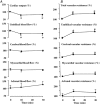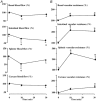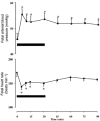The role of neuropeptide Y in the ovine fetal cardiovascular response to reduced oxygenation
- PMID: 12563013
- PMCID: PMC2342585
- DOI: 10.1113/jphysiol.2002.034488
The role of neuropeptide Y in the ovine fetal cardiovascular response to reduced oxygenation
Abstract
This study investigated the role of neuropeptide Y (NPY) in mediating cardiovascular responses to reduced oxygenation in the late gestation ovine fetus by: (1) comparing the effects on the cardiovascular system of an exogenous infusion of NPY with those elicited by moderate or severe reductions in fetal oxygenation; and (2) determining the effect of fetal I.V. treatment with a selective NPY-Y(1) receptor antagonist on the fetal cardiovascular responses to acute moderate hypoxaemia. Under general anaesthesia, 14 sheep fetuses (0.8-0.9 of gestation) were surgically prepared with vascular and amniotic catheters. In 5 of these fetuses, a Transonic flow probe was also implanted around a femoral artery. Following at least 5 days of recovery, one group of fetuses (n = 9) was subjected to a 30 min treatment period with exogenous NPY (17 microg kg(-1) bolus plus 0.85 microg kg(-1) min(-1) infusion). In this group, fetal blood pressure and heart rate were monitored continuously and the distribution of the fetal combined ventricular output was assessed via injection of radiolabelled microspheres before and during treatment. The second group of fetuses instrumented with the femoral flow probe (n = 5) were subjected to a 3 h experiment consisting of 1 h of normoxia, 1 h of hypoxaemia, and 1 h of recovery during a slow I.V. infusion of vehicle. One or two days later, the acute hypoxaemia protocol was repeated during fetal I.V. treatment with a selective NPY-Y(1) receptor antagonist (50 microg kg(-1) bolus + 1.5 microg kg(-1) min(-1) infusion). In these fetuses, fetal arterial blood pressure, heart rate and femoral vascular resistance were recorded continuously. The results show that fetal treatment with exogenous NPY mimics the fetal cardiovascular responses to asphyxia, and that treatment of the sheep fetus with a selective NPY-Y(1) receptor antagonist does not affect the fetal cardiovascular response to acute moderate hypoxaemia. These results support a greater role for NPY in mediating the fetal cardiovascular responses to acute asphyxia than to acute moderate hypoxaemia.
Figures





References
-
- Alexander DP, Bashore RA, Britton HG, Forsling ML. Ternal and fetal arginine vasopressin in the chronically catheterised sheep. Biol Neonate. 1974;25:242–248. - PubMed
-
- Allen JM, Adrian TE, Polak JM, Bloom SR. Neuropeptide Y (NPY) in the adrenal gland. J Auton Nerv Syst. 1983a;9:559–563. - PubMed
-
- Balasubramaniam A. Neuropeptide Y family of hormones: receptor subtypes and antagonists. Peptides. 1997;18:445–457. - PubMed
-
- Balasubramaniam A, Zhai W, Sheriff S, Tao Z, Chance WT, Fischer JE, Eden P, Taylor J. Bis (31/31′)Cys31, Trp32, Nva34] NPY-(31–36): a specific NPY-Y1 receptor antagonist. J Med Chem. 1996;39:811–813. - PubMed
-
- Bartelds B, van Bel F, Teitel DF, Rudolph AM. Carotid, not aortic, chemoreceptors mediate the fetal cardiovascular response to acute hypoxemia in lambs. Pediatr Res. 1993;34:51–55. - PubMed
Publication types
MeSH terms
Substances
LinkOut - more resources
Full Text Sources
Miscellaneous

